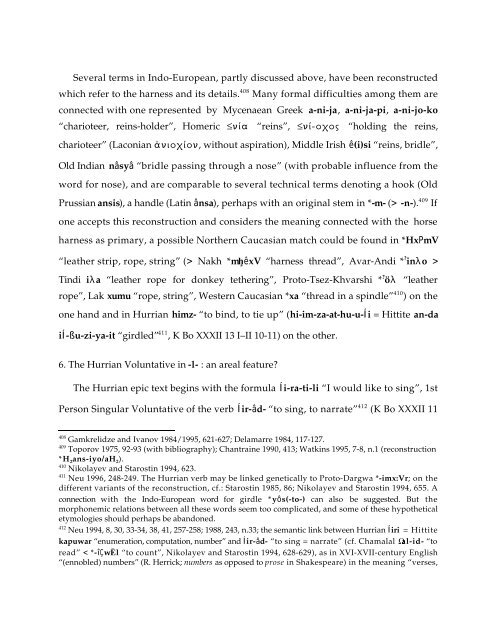Comparative Notes on Hurro-Urartian, Northern Caucasian
Comparative Notes on Hurro-Urartian, Northern Caucasian
Comparative Notes on Hurro-Urartian, Northern Caucasian
Create successful ePaper yourself
Turn your PDF publications into a flip-book with our unique Google optimized e-Paper software.
Several terms in Indo-European, partly discussed above, have been rec<strong>on</strong>structed<br />
which refer to the harness and its details. 408 Many formal difficulties am<strong>on</strong>g them are<br />
c<strong>on</strong>nected with <strong>on</strong>e represented by Mycenaean Greek a-ni-ja, a-ni-ja-pi, a-ni-jo-ko<br />
“charioteer, reins-holder”, Homeric ≤n¤a “reins”, ≤n¤-oxow “holding the reins,<br />
charioteer” (Lac<strong>on</strong>ian éniox¤<strong>on</strong>, without aspirati<strong>on</strong>), Middle Irish ê(i)si “reins, bridle”,<br />
Old Indian nâsyâ “bridle passing through a nose” (with probable influence from the<br />
word for nose), and are comparable to several technical terms denoting a hook (Old<br />
Prussian ansis), a handle (Latin ânsa), perhaps with an original stem in *-m- (> -n-). 409 If<br />
<strong>on</strong>e accepts this rec<strong>on</strong>structi<strong>on</strong> and c<strong>on</strong>siders the meaning c<strong>on</strong>nected with the horse<br />
harness as primary, a possible <strong>Northern</strong> <strong>Caucasian</strong> match could be found in *HxPmV<br />
“leather strip, rope, string” (> Nakh *m êxV “harness thread”, Avar-Andi * ? inlo ><br />
Tindi ila “leather rope for d<strong>on</strong>key tethering”, Proto-Tsez-Khvarshi * ? öl “leather<br />
rope”, Lak xumu “rope, string”, Western <strong>Caucasian</strong> *xa “thread in a spindle” 410 ) <strong>on</strong> the<br />
<strong>on</strong>e hand and in Hurrian himz- “to bind, to tie up” (hi-im-za-at-hu-u-Íi = Hittite an-da<br />
iÍ-ßu-zi-ya-it “girdled” 411 , K Bo XXXII 13 I–II 10-11) <strong>on</strong> the other.<br />
6. The Hurrian Voluntative in -l- : an areal feature?<br />
The Hurrian epic text begins with the formula Íi-ra-ti-li “I would like to sing”, 1st<br />
Pers<strong>on</strong> Singular Voluntative of the verb Íir-âd- “to sing, to narrate” 412 (K Bo XXXII 11<br />
408 Gamkrelidze and Ivanov 1984/1995, 621-627; Delamarre 1984, 117-127.<br />
409 Toporov 1975, 92-93 (with bibliography); Chantraine 1990, 413; Watkins 1995, 7-8, n.1 (rec<strong>on</strong>structi<strong>on</strong><br />
*H 2ans-iyo/aH2). 410 Nikolayev and Starostin 1994, 623.<br />
411 Neu 1996, 248-249. The Hurrian verb may be linked genetically to Proto-Dargwa *-imx:Vr; <strong>on</strong> the<br />
different variants of the rec<strong>on</strong>structi<strong>on</strong>, cf.: Starostin 1985, 86; Nikolayev and Starostin 1994, 655. A<br />
c<strong>on</strong>necti<strong>on</strong> with the Indo-European word for girdle *yôs(-to-) can also be suggested. But the<br />
morph<strong>on</strong>emic relati<strong>on</strong>s between all these words seem too complicated, and some of these hypothetical<br />
etymologies should perhaps be aband<strong>on</strong>ed.<br />
412 Neu 1994, 8, 30, 33-34, 38, 41, 257-258; 1988, 243, n.33; the semantic link between Hurrian Íiri = Hittite<br />
kapuwar “enumerati<strong>on</strong>, computati<strong>on</strong>, number” and Íir-âd- “to sing = narrate” (cf. Chamalal Ωal-id- “to<br />
read” < *-îÇw l “to count”, Nikolayev and Starostin 1994, 628-629), as in XVI-XVII-century English<br />
“(ennobled) numbers” (R. Herrick; numbers as opposed to prose in Shakespeare) in the meaning “verses,





